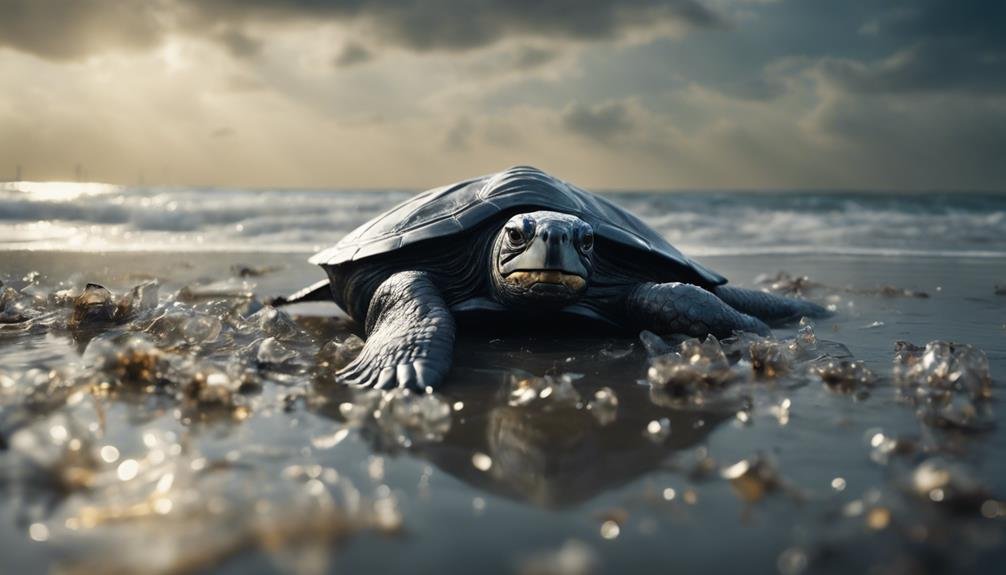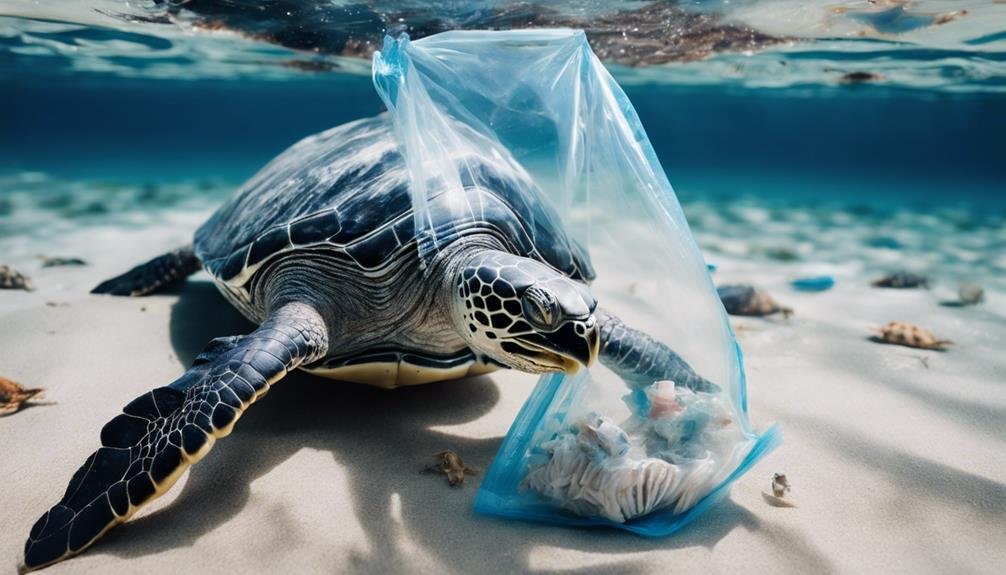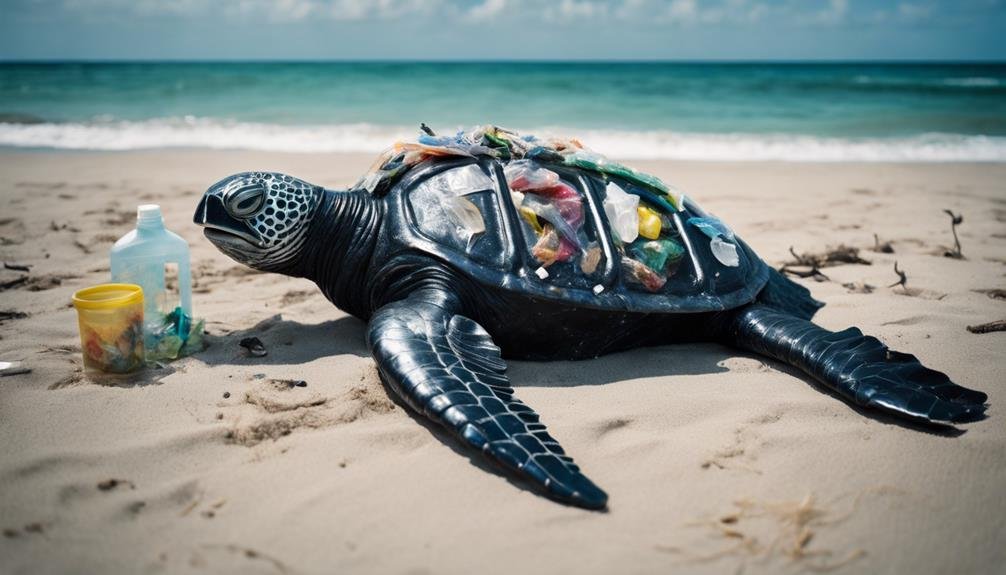You’ve likely heard that leatherback sea turtles are endangered, but you may not fully grasp the gravity of their situation. These majestic creatures face numerous threats, from illegal egg harvesting to habitat destruction and beyond. As someone who cares about the natural world, it’s essential you understand not just the ‘what’ but the ‘why’ behind their plight, and more importantly, how your actions can make a difference. The path to change is paved with knowledge and action. So, let’s explore the challenges leatherback sea turtles face and uncover what steps you can take to contribute to their preservation. What you discover may surprise you and inspire a deeper commitment to their cause.
Key Takeaways
- Leatherback sea turtles face endangerment due to illegal egg harvesting and capture for meat.
- Entanglement in fishing gear causes significant mortality, with around 1,000 deaths yearly in U.S. waters.
- Marine pollution, including plastic debris and oil spills, severely impacts their health and feeding grounds.
- Climate change affects their reproductive success and threatens nesting beaches with rising sea levels.
- Preventing endangerment involves reducing marine pollution, enforcing fishing regulations, and protecting nesting habitats.
Threats to Leatherback Turtles
Leatherback sea turtles frequently face endangerment due to a variety of threats, including illegal egg harvesting, capture for meat, and habitat destruction. The Pacific Leatherback Turtles, in particular, are in a critical state, with commercial fisheries exacerbating their plight. As they navigate the vast Pacific, these ancient mariners often become entangled in fishing lines or nets, severely hindering their ability to swim to the surface to breathe. This not only puts individual turtles at risk but also contributes greatly to the decline in leatherback populations.
Furthermore, the very nesting habitats crucial for their survival are being encroached upon by coastal development. This disruption not only affects their breeding grounds but also exposes hatchlings to a higher risk of predation and disorientation due to artificial lighting. It’s a grim reality that, without intervention, the majestic journey of these creatures from beach to ocean could become a thing of the past.
Commercial fisheries, while important to the economy, pose a direct threat to leatherbacks. The incidental catch, known as bycatch, can lead to drowning or severe injury for these turtles. It’s important to recognize the impact of fishing practices on leatherback populations and work towards solutions that protect these ancient ocean navigators while supporting sustainable fishing.
Poaching and Illegal Trade
You’ve learned about the threats leatherback sea turtles face, but it’s important to understand the role poaching and illegal trade play in their endangerment.
We’ll explore the reasons behind poaching, its dire impact on turtle populations, and the efforts to combat illegal trade.
Reasons Behind Poaching
To comprehend why leatherback sea turtles face such a high risk of endangerment, it’s crucial to explore the driving forces behind poaching and the illegal trade of their parts. Poachers target leatherback nests on nesting beaches, drastically reducing hatchling survival rates. This is largely driven by the demand for leatherback products, such as eggs, meat, and skin, particularly in regions where these items are highly valued.
This illegal trade severely impacts vulnerable populations, disrupting their natural reproductive cycles and threatening their survival. The enforcement of regulations and ramping up monitoring efforts are critical steps in combating poaching. Protecting these majestic creatures from illegal trade demands your awareness and action to secure their survival for generations to come.
Impact on Turtle Populations
Understanding the reasons behind poaching reveals its devastating impact on leatherback sea turtle populations, as illegal activities continue to drive them towards endangerment. Leatherbacks face extinction from poaching that targets both adults and their eggs, considered a delicacy in some regions. The illegal trade of these eggs poses a significant challenge to conservation efforts, undermining the survival of this endangered species.
| Threat | Target | Impact |
|---|---|---|
| Poaching | Adult Turtles | Decline in population |
| Illegal Trade | Turtle Eggs | Hinders conservation efforts |
| Consumption Demand | Eggs as Delicacy | Increases poaching activities |
Efforts to combat these illegal practices are essential in safeguarding leatherback sea turtles from further endangerment and potential extinction.
Combating Illegal Trade
Addressing the illegal trade head-on, including poaching, is crucial in protecting endangered leatherback sea turtles from further decline. The illegal trade, especially poaching for eggs, meat, and skin, severely impacts leatherback populations. You play an essential role in combatting this threat. Here’s how:
- Report illegal activities: If you witness poaching or illegal trade, report it to local authorities or wildlife conservation organizations.
- Support enforcement efforts: Back initiatives and laws aimed at bolstering enforcement against illegal trade.
- Educate others: Spread awareness about the impact of illegal trade on leatherback sea turtles to discourage participation in or support for these activities.
Together, through increased enforcement and public awareness, we can combat the illegal trade threatening leatherback sea turtles.
Fishing Gear Entanglement
Leatherback sea turtles face a deadly threat from entanglement in fishing gear, resulting in around 1,000 deaths every year in U.S. waters alone. These magnificent creatures often find themselves caught in longline, gillnet, and trawl fishing gear, leading to severe injuries, drowning, or death. Leatherbacks are particularly vulnerable as they forage for jellyfish near the surface, exactly where fishing gear is commonly deployed.
You might wonder how such a tragedy continues to occur. Despite regulations like Turtle Excluder Devices (TEDs) in shrimp trawls, which are designed to reduce leatherback bycatch, enforcement and compliance are ongoing challenges. It’s not just about setting rules; it’s about ensuring they’re followed.
Marine Pollution Impact


You’ve seen how fishing gear can trap and harm leatherback sea turtles, but the danger doesn’t stop there.
The ocean’s pollution, from plastic debris to oil spills and chemical contaminants, poses a serious threat to their survival.
Let’s explore how these pollutants impact leatherback turtles and what can be done to mitigate these risks.
Plastic Debris Threats
Plastic debris in the oceans frequently entangles and fatally harms leatherback sea turtles, posing a significant threat to their survival. When you consider the impact of plastic pollution, it’s important to recognize how it affects these majestic marine animals. Leatherback turtles often mistake plastic bags for jellyfish, leading to ingestion that can cause internal blockages, starvation, and ultimately, death. The entanglement in plastic waste not only injures them but also hampers their ability to swim, find food, or escape predators.
- Plastic bags lead to ingestion and entanglement, mimicking the turtles’ natural prey.
- Single-use plastics contribute significantly to the debris that endangers marine life.
- Marine animals, including leatherback turtles, suffer from reduced reproductive success due to plastic ingestion, threatening their population.
Reducing single-use plastics and participating in beach clean-ups are crucial steps in preventing further endangerment of leatherback sea turtles.
Oil Spills Harm
Oil spills, a devastating form of marine pollution, severely harm leatherback sea turtles by contaminating their essential feeding grounds and prey. When oil leaks into the ocean, it doesn’t just float on the surface; it invades the habitats where leatherbacks forage, making their quest for food perilous.
You mightn’t realize it, but leatherback sea turtles are especially at risk due to their preference for areas where oil is often explored and transported. This oily coating not only messes with their ability to stay warm but also leads to dire internal damage when they ingest contaminated prey.
That’s why immediate cleanup efforts are so crucial. They’re not just about removing the oil; they’re about saving these magnificent creatures and their ecosystems from long-lasting harm.
Chemical Contaminants Effects
While oil spills pose a significant threat to leatherback sea turtles, chemical contaminants in the ocean also play a devastating role in their endangerment. These harmful substances, including pesticides, heavy metals, and plastics, are a significant factor in making leatherback sea turtles endangered. They wreak havoc in several ways:
- Disruption of hormones and immune systems, compromising their ability to survive and reproduce.
- Ingestion of plastic debris leads to internal injuries and blockages, threatening their lives.
- Accumulation of contaminants in their tissues affects overall health and survival chances.
To protect these magnificent creatures, it’s essential to reduce marine pollution. Advocating for cleaner oceans and proper waste disposal can make a difference in preventing the endangerment of leatherback sea turtles.
Climate Change Effects


Climate change greatly impacts leatherback sea turtles, altering their reproductive success and survival rates. As you’re learning about the challenges these majestic creatures face, it’s essential to understand how climate change plays a significant role.
The alteration in ocean conditions, primarily due to climate change, directly affects leatherback sea turtles’ ability to reproduce and achieve nesting success. Warmer waters, a result of our changing climate, skew the sex ratio of hatchlings towards females because nest temperature determines their sex. This imbalance can have long-term effects on their population dynamics.
Moreover, the changing ocean chemistry, another consequence of climate change, impacts leatherbacks’ habitat and the availability of their prey, which in turn affects their survival. The situation is exacerbated by rising sea levels and more severe storms, threatening the very beaches where leatherbacks lay their eggs and the survival of their hatchlings. These turtles face significant challenges in adapting to these rapidly changing marine environments, highlighting the urgent need for action to mitigate climate change impacts.
As you dive deeper into the plight of leatherback sea turtles, remember, their future is intertwined with the health of our planet’s oceans and climate.
Beach Erosion Concerns
Beach erosion, worsened by coastal development and rising sea levels, greatly reduces the habitat available for leatherback sea turtles to nest, posing a dire threat to their populations. As you’re aware, these majestic creatures depend on undisturbed sandy beaches for the successful incubation of their eggs. Yet, the increasing impact of human activities and the wrath of nature through storms are accelerating the loss of these critical nesting sites.
To grasp the seriousness of the situation, consider the following points:
- Leatherback sea turtles’ nesting success is directly tied to the availability and condition of nesting beaches. Beach erosion not only shrinks these spaces but can also degrade the quality of the remaining habitat.
- Coastal development acts as a double-edged sword, contributing to beach erosion while also introducing pollutants and artificial lighting, which further disrupt nesting activities.
- Conservation efforts are important in this scenario. They aim to protect and restore nesting beaches by managing coastal development and implementing measures to counteract beach erosion.
You play a role in this scenario. Supporting conservation efforts and advocating for responsible coastal development practices can help mitigate beach erosion’s impact on leatherback sea turtle nesting habitats. Together, we can make sure these ancient mariners have a fighting chance for survival.
Reproductive Challenges


Leatherback sea turtles encounter significant reproductive obstacles, particularly influenced by temperature-dependent sex determination, which skews their populations toward more females in warmer conditions. This imbalance, exacerbated by climate change, creates a challenging scenario for leatherback embryo development. You’ve got climate change-induced variations, like increased rainfall and drought, altering the very nesting conditions these turtles rely on. This not only affects the development of embryos but also the survival rates of hatchlings.
Severe storms and hurricanes, now more frequent and intense due to climate change, lead to increased nest loss and habitat destruction. Imagine the struggle as critical nesting sites are washed away, leaving leatherbacks with fewer places to lay their eggs safely. Additionally, artificial lights pose a unique challenge. These lights disorient nesting females and emerging hatchlings, drastically reducing their chances of survival.
The loss of critical nesting sites further compounds these reproductive challenges. With fewer safe places to nest, the impact of every threat is magnified, from plastic ingestion to the lurking dangers of commercial fisheries. Each factor plays a part in the challenging reproductive challenges leatherback sea turtles face today.
Conservation Efforts
Facing these reproductive challenges, efforts to conserve leatherback sea turtles have ramped up, focusing on safeguarding their habitats and enhancing their survival prospects. Recognizing the myriad threats these ancient mariners face, from poaching to entanglement in fishing gear, the response has been multifaceted. You’re now seeing a concerted push to protect critical nesting habitats from the impact of beach erosion and climate change. Warming temperatures, a direct threat to the reproductive success of these turtles, have made this mission more essential than ever.
Key strategies in the conservation toolkit include:
- Protecting critical nesting habitats to ensure these turtles have a safe place to lay their eggs. This involves both legal protection and physical measures to minimize beach erosion and other forms of habitat degradation.
- Implementing Turtle Excluder Devices (TEDs) in fishing nets to prevent accidental capture and drowning, a significant step toward reducing bycatch.
- Supporting CITES trade restrictions to curb the illegal trade of leatherback sea turtles and their parts, tackling the problem of poaching head-on.
Together, these efforts aim to mitigate the impact of marine pollution and other human-induced hazards, offering a glimmer of hope for the future of leatherback sea turtles.
How You Can Help


You can play an important role in protecting leatherback sea turtles by getting involved with conservation efforts and advocating for their survival. As these magnificent creatures face the threat of becoming an endangered species, your actions can make a significant difference. By supporting conservation organizations like the Turtle Island Restoration Network, you’re contributing to the protection of leatherback sea turtles and their habitats.
Getting your hands dirty during local beach cleanups can also have a profound impact. Reducing pollution not only benefits the environment but guarantees safer nesting grounds for leatherback sea turtles. If you’re near coastal areas, reporting sightings of leatherback sea turtles or their nesting activities to conservation authorities is essential for their monitoring and protection.
Educate yourself and others about the threats leatherback sea turtles face by participating in educational programs. Spreading awareness is a powerful tool in the conservation arsenal. Finally, advocate for improved fishing practices. By pushing for regulations that reduce bycatch, you’re helping to ensure that leatherback sea turtles don’t inadvertently become victims of fishing gear.
Your actions, no matter how small, contribute to the survival of leatherback sea turtles. It’s up to all of us to ensure these majestic creatures aren’t just a memory for future generations.
What Can We Learn from the Ancient History of Leatherback Sea Turtles to Help Prevent Endangerment?
The leatherback sea turtles history timeline offers valuable lessons for preventing endangerment. Studying their ancient behaviors, habitats, and survival skills can help inform conservation efforts today. Understanding their historical population trends and environmental changes can guide modern initiatives to protect these endangered species.
Frequently Asked Questions
How Can We Prevent Sea Turtle Extinction?
To prevent sea turtle extinction, you can start by supporting stricter fishing regulations to cut down bycatch and backing conservation efforts aimed at protecting their nesting beaches.
You should also spread awareness about the threats they face from climate change, pollution, and habitat loss.
Practicing responsible tourism and engaging in advocacy for their protection are vital steps, too.
Every action counts in ensuring the survival of these magnificent creatures for future generations.
Why Should We Save Leatherback Sea Turtles?
You should save leatherback sea turtles because they play a vital role in marine ecosystems, controlling jellyfish populations and maintaining biodiversity.
Their decline, by 40% over the past generations, shows the urgent need for action.
By supporting conservation efforts and reducing pollution, you’re not just saving a species but also preserving ocean balance.
Your awareness and actions can make a significant difference in preventing their endangerment and ensuring their survival for future generations.
How Do Leatherback Turtles Protect Themselves?
Leatherback turtles have got a few cool tricks up their sleeves to protect themselves. They boast a soft, rubbery shell that’s pretty unique among turtles.
They can dive deep, up to 4,000 feet, to escape predators and find food. Plus, they’ve got this thick layer of fat to keep warm in cold waters.
They’re also pretty big and fast, reaching speeds of up to 22 miles per hour to dodge threats.
Why Should Humans Protect Sea Turtles?
You should protect sea turtles because they’re essential for marine ecosystems, keeping jellyfish populations in check and maintaining the ocean’s health. By helping these ancient creatures, you’re contributing to biodiversity and supporting indicators of ocean well-being.
Your efforts in conservation lead to the preservation of pivotal nesting habitats, benefiting countless other species. Protecting them upholds our ethical duty to safeguard endangered species, ensuring a healthier planet for future generations.
Conclusion
To sum up, you’ve witnessed how human actions are driving leatherback sea turtles towards extinction. From poaching to climate change, these gentle giants face numerous threats. But there’s hope if you act.
By reducing plastic use, supporting sustainable fishing, and advocating for cleaner oceans, you can make a difference. Your efforts in raising awareness and backing conservation initiatives are crucial.
Together, let’s protect these magnificent creatures and their habitats for future generations. Every action counts.



[…] are also at risk. Efforts to protect these habitats and regulate human activities are essential for leatherback sea turtle endangerment prevention. Conservation initiatives are needed to ensure the long-term survival of this […]